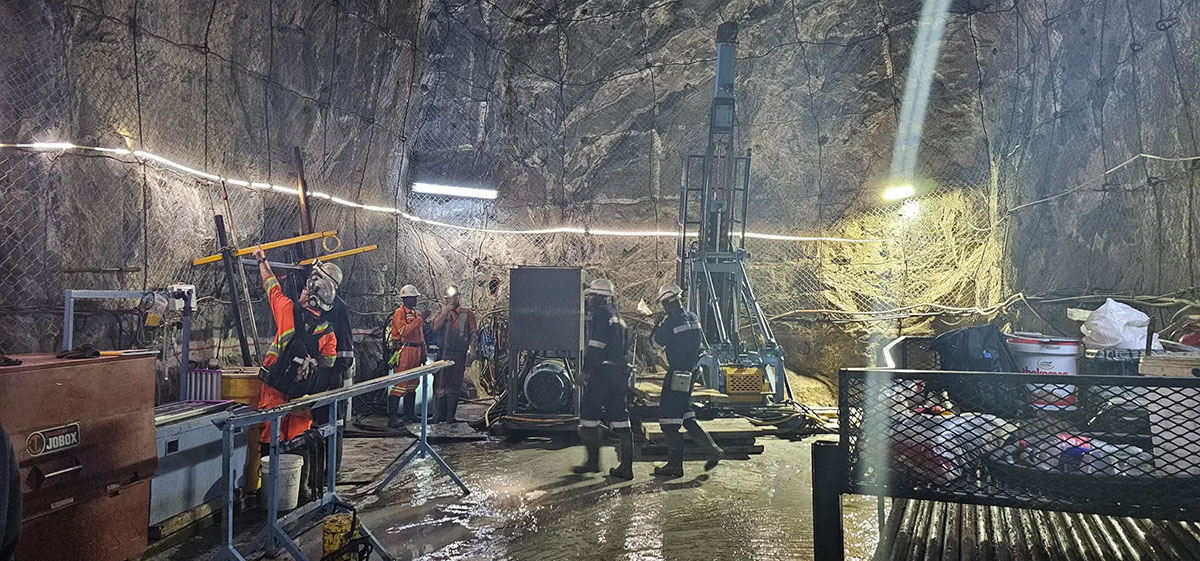NexMetals Mining Eliminates Smelter Risk and Secures US$80M to Fast-Track Botswana Copper-Nickel Assets

NexMetals eliminates US$21M debt, raises US$80M, solves metallurgy challenges removing US$1B+ smelter requirement at Botswana copper-nickel assets. PEAs due 2026.
- NexMetals Mining, led by CEO Morgan Lekstrom, has transformed its capital structure by eliminating US$21 million in debt and securing an US$80 million financing led by new institutional investor Condire Capital, with existing major shareholder EdgePoint also participating substantially in the raise.
- The company has solved critical metallurgical challenges at its two past-producing Botswana assets by eliminating the need for a billion-dollar-plus smelter through concentrate-splitting technology, fundamentally reducing capital requirements and project risk while enabling cobalt recovery for the first time.
- NexMetals' Selebi underground asset contains approximately 30 million tonnes at 3.35% copper equivalent (roughly 1.75% copper and 1.75% nickel), whilst the Selkirk open-pit project hosts over 200 million tonnes of mineralised material, with 44 million tonnes currently in resource following reassaying of 30,000 metres of historical core.
- The company's strategy centres on demonstrating scale through aggressive exploration in 2026, with preliminary assessments planned for both assets, targeting sub-US$500 million capital requirements per project and positioning for either production decisions or strategic transactions within a two-year timeframe.
- Management has assembled an experienced board including former BlackRock CIO Chris Levy, former Gatos Silver CFO Andre Vanderkerk, and ESG specialist Philippa Avaris, whilst maintaining 99.9% Botswana national employment and operating in Africa's longest-standing democracy with established mining infrastructure.
Strategic Recapitalisation Positions Company for Growth
NexMetals Mining Corp (TSXV:NEXM | NASDAQ:NEXM) has completed a transformative recapitalisation that fundamentally alters the investment proposition for its two past-producing copper-nickel-cobalt assets in Botswana. The company recently closed an US$80 million equity financing led by new institutional investor Condire Capital of Texas, with participation from existing major shareholder EdgePoint Investment Group, bringing the company's institutional ownership to approximately 75%, up from 30% at the beginning of 2024.
CEO Morgan Lekstrom explained the strategic imperative behind the financing: "There were fundamental things that you do when you're looking at raising money in the company side of things. When we got involved in this company in March, there was $21 million of debt on the book on the equity stack. There was a payment coming up of 35 million Canadian or 25 US coming up in January to March."
The financing eliminates all outstanding debt obligations and removes a significant market overhang. As Lekstrom noted:
"We took the medicine right now, the final cleanup stage, and now we can advance the assets. So, we're well capitalised to do that."
With approximately US$90 million in the bank following the raise, the company is positioned to execute its 2026 exploration and development programme without near-term financing requirements.
Solving the Smelter Problem
Perhaps the most significant technical achievement has been NexMetal's solution to metallurgical challenges that plagued previous operators. The original operation utilised a bulk concentrate smelter that has since been dismantled by subsequent owners. Rather than contemplate rebuilding smelter infrastructure - which would require over US$1 billion in capital and substantially increase project risk - the company has developed concentrate-splitting technology that fundamentally changes the economics. Lekstrom explained:
"We went out, we raised the money, we solved that metallurgy issue, and now we can split the concentrates...I still don't think the markets quite understood how big that was for the company. You've taken a project that required a billion plus dollar smelter to be built to run it to not require that anymore. So you've deleted a huge amount of capex and opex potentially out of the project."
The metallurgical breakthrough enables several strategic advantages. First, it dramatically reduces capital intensity, with management targeting sub-US$500 million construction costs per asset - a fraction of what integrated smelter operations would require. Second, the concentrate-splitting capability allows optimisation of the orebody without metallurgical constraints, potentially enabling selective mining of higher-grade zones. Third, and perhaps most significantly, the technology now permits cobalt recovery, which previous operations could not economically achieve.
Asset Overview & Resource Potential
NexMetals' controls two past-producing assets in Botswana's Kalahari Copper Belt. The Selebi asset represents an underground operation that produced continuously for over 30 years, with existing underground workings providing several years of access without additional development. The current resource stands at approximately 30 million tonnes grading 3.35% copper equivalent, comprising roughly 1.75% copper and 1.75% nickel. Notably, cobalt grades have not yet been incorporated into the resource estimate, though the company expects to include them following metallurgical test work demonstrating recoveries. Lekstrom explained:
"That's just about 30 million tons at 3.35% copper equivalent. That's about 1.75% roughly, 1.75% copper, 1% nickel, and the cobalt we didn't actually include in the resource, right? But we will because now we can recover it."
The Selkirk asset presents a different opportunity profile. An open-pit deposit, Selkirk hosts over 200 million tonnes of mineralised horizon, though only 44 million tonnes currently feature in the resource estimate. This limitation stems from incomplete assaying of platinum and palladium values in historical drill core. Upon acquiring the assets, management initiated a comprehensive reassay programme.
"When our team came in, they said, 'Let's reassay some of the core.' And we only reassayed a very small amount. So with this last raise, we went out and we did a full comprehensive reassay campaign of all the core. Like 30,000 [metres]. It was crazy. Like a lot of metres...They pinholed that resource. So when we do an MRE update in Q1, it will be in the M&I [measured and indicated]. It will be with hopefully the metallurgy completed, which we're doing right now."
The company drilled 13 holes at Selkirk to support ongoing metallurgical test work and expects to release preliminary assessment-level economics in Q2 2026.
Interview with NexMetals Mining's CEO Morgan Lekstrom
Exploration Upside & Geophysical Targeting
Beyond the existing resource base, NexMetals has identified substantial exploration potential through modern geophysical techniques that previous operators did not employ. Specifically, electromagnetic surveys have identified numerous conductive anomalies strongly associated with copper-nickel-cobalt mineralisation, effectively providing targeting data for systematic drill testing.
This systematic approach has delivered consistent results. "If you look on our presentation, you'll see a bunch of yellow boxes like someone pencil crayoned them in. That is every time we hit one of those, we just find more. So I don't anticipate that's going to change going forward," he added.
The company's exploration philosophy emphasises demonstrating scale before committing to economic studies. Rather than optimising a smaller, near-term production scenario that might sterilise portions of the orebody, management intends to delineate sufficient resources to support 15-20 year mine lives at optimal throughput rates. This approach may take an additional year but positions the assets for either internal development or strategic transactions at significantly higher valuations.
2026 Catalysts & Development Pathway
NexMetals has outlined an aggressive 2026 programme designed to deliver multiple value inflection points. The company expects to complete preliminary assessments on both Selebi and Selkirk, providing initial economic frameworks for each asset. Concurrent exploration drilling will target resource expansion, particularly at Selebi North where electromagnetic anomalies indicate substantial additional mineralisation.
"We're going to have two economic studies in 2026. We're going to have all the expansion work. We're going to use this money to show scale and size," Lekstrom stated. "Selkirk may even be a joint venture or a sale opportunity that we could look to monetise in a way that is non-dilutive to shareholders going forward."
The dual-track strategy provides optionality. Management views Selebi as the company's flagship asset, with higher grades and underground mining methods suited to potential internal development. Selkirk, with its open-pit profile and palladium-platinum credits, may attract joint venture interest or outright acquisition proposals, potentially providing non-dilutive funding for Selebi advancement.
Lekstrom emphasised the compressed development timeline: "I'm a big believer in compressing time value of money. If you look at our share price right now, you'd go do you believe that? You do because of the amount of work we've done in such a short time. The amount of things we've solved in a short amount of time. The amount of things we're going to get done in 2026, we're fully funded to do it."
Jurisdictional Considerations
Botswana represents a relatively unknown jurisdiction for many North American investors, though it has hosted large-scale mining operations for decades. The country is Africa's longest-standing democracy, having recently celebrated 59 years of continuous democratic governance. Current mining operations include MMG's Khoemacau copper mine, Sandfire Resources' projects, De Beers diamond operations, and recent exploration initiatives by BHP. Lekstrom stated:
"Botswana's the safest jurisdiction in Africa...I can walk around at night. Everyone's very friendly. It's the most friendly people you'd ever meet. Very well trained and high skilled."
The country maintains a population of only 2.5 million, but invests substantially in education and training. "What they do is they send their top people out to Canada to get engineering training, Europe. So you end up with very talented people that can run mines. Ninety-nine point nine percent of our people in Botswana are Batswana," Lekstrom noted.
Notably, Botswana's economy has historically relied heavily on diamond production, which has faced headwinds as synthetic diamonds and changing consumer preferences affect demand. This context has made the government particularly supportive of diversification into base and battery metals, potentially creating a favourable regulatory environment for projects like NexMetals'.
Management & Board Composition
NexMetals has assembled a team with substantial mine-building and transaction experience. CEO Morgan Lekstrom brings experience from mine construction in multiple African jurisdictions, whilst President Sean Whiteford's background includes technical roles at BHP, Rio Tinto, and Cliffs Natural Resources. The division of responsibilities sees Lekstrom managing financial, capital markets, and strategic functions whilst Whiteford oversees technical operations and exploration.
The board includes several notable additions since early 2024. Chris Leavy, former CIO of BlackRock's US equities division and former CEO of Oppenheimer Funds, brings institutional capital markets expertise. "Chris is very involved, not just a name. Very highly intelligent. Wanted to learn more. So we went and took metallurgy courses and mine economic courses. I'm pretty sure he knows more than me about mine economics now," Lekstrom said.
Philipa Avaris, recognised as a leading ESG specialist in mining, conducted extensive due diligence before joining. "Took her four months of doing DD to even want to get involved. I've known Philippa for a very long time and she had all the calls, talked to all the people, wanted to make sure this was sustainable, doing the community relations correctly," Lekstrom explained.
André van Niekerk, former CFO of Gatos Silver (acquired for US$1.2 billion), adds transaction experience. Combined with Chairman Paul Martin (former CEO of Detour Gold) and COO Boris Kampster (with extensive African mine-building experience), the team covers exploration, development, operations, and exit scenarios.
"When I say E to P and E to S, exploration to production and to either sale, our team has done that holistically," Lekstrom said. "You have a board with every facet you want from E to P or E to S."
Strategic Rationale & Market Positioning
Management's thesis centres on copper and nickel supply deficits driven by electrification and energy transition demand. Multiple major mining companies - including BHP, Anglo American (through its acquisition of Anglo American by BHP being blocked, but Anglo's subsequent acquisition of smaller copper assets), and various technology companies - are actively seeking copper exposure. NexMetals positions itself as a near-term development opportunity with past production, existing infrastructure, and solved metallurgical challenges.
"Who wants copper at the moment? Everyone. Tech's investing in different areas of the world. BHP is hard looking for copper. Anglo buying tech is a big bet for copper. Kamoa Kakula with Robert Friedland, he talks about copper being the biggest thing that you need right now, always, 24/7," Lekstrom said.
Financial Position & Funding Strategy
Following the recent financing, NexMetals holds approximately US$90 million in cash after settling all outstanding obligations. Management emphasises that this capital fully funds the 2026 work programme, eliminating near-term financing requirements and associated dilution risk. The strategic timing proved fortuitous, as market conditions have deteriorated since the financing closed.
"We have US$90[million] in the bank right now. We don't need to come back to you anytime soon."
The company raised nearly 100% of its market capitalisation at the time of financing - an unusual quantum that reflects both the assets' perceived value and the credibility management established with institutional investors. EdgePoint, the company's largest shareholder, increased its position despite having no obligation to participate.
The Investment Thesis for NexMetals Mining
- Structural Capital Efficiency: The elimination of smelter requirements reduces estimated capital intensity to sub-US$500 million per asset versus the US$1+ billion required for integrated operations, fundamentally improving project economics and reducing financing risk.
- De-Risked Asset Base: Both properties are past producers with existing underground workings (Selebi) and mining permits, eliminating exploration risk, permitting uncertainty, and metallurgical unknowns that plague grassroots projects.
- Near-Term Catalysts: Preliminary assessments on both assets expected in 2026 provide concrete valuation inflection points, whilst ongoing exploration drilling may substantially expand resources, particularly at Selebi where electromagnetic targeting has consistently delivered mineralisation.
- Quality Institutional Backing: The addition of Condire Capital as a 9.9% shareholder and EdgePoint's continued support indicates sophisticated investors have underwritten management's strategy; 75% institutional ownership reduces volatility and provides potential M&A facilitation.
- Strategic Optionality: Management's dual-track approach - developing Selebi internally whilst potentially monetising Selkirk through joint venture or sale - provides non-dilutive funding pathways and reduces binary outcome risk.
- Jurisdictional Advantage: Botswana's 59-year democratic track record, existing mining infrastructure (MMG, Sandfire, De Beers, BHP), skilled workforce, and government support for economic diversification away from diamonds create a favourable operating environment relative to other African jurisdictions.
- Proven Management Team: Board and executive team have collectively built mines (Kampster, Whiteford), completed strategic transactions (van Niekerk at Gatos Silver), and managed institutional capital (Leavy at BlackRock), reducing execution risk.
- Commodity Exposure: Copper-nickel-cobalt-platinum-palladium basket provides diversified exposure to electrification megatrends (copper, nickel, cobalt) and industrial demand (PGMs), with ability to optimise mine plans based on commodity price dynamics.
- Compressed Timeline: Management's emphasis on "compressing time value of money" through aggressive 2026 programmes and two-year strategic timeline creates potential for rapid value realisation versus typical 5-10 year junior mining development cycles.
- Fully Funded Programme: With US$90 million in cash and no debt, the company can execute its 2026 work programme without near-term financing requirements, eliminating dilution risk and allowing management to focus on operational execution
TL;DR
NexMetals Mining closed an US$80 million financing that eliminated debt, increased institutional ownership to 75%, and provided full funding for 2026 programmes. The company solved critical metallurgical challenges at two past-producing Botswana copper-nickel-cobalt assets, eliminating the need for a US$1+ billion smelter and reducing capital intensity to sub-US$500 million per project. Selebi contains 30 million tonnes at 3.35% copper equivalent with existing underground infrastructure, whilst Selkirk hosts over 200 million tonnes of mineralised material. Management expects preliminary assessments on both assets in 2026 alongside aggressive exploration programmes, positioning for production decisions or strategic transactions within two years. The board combines mine-building, transaction, and institutional capital markets experience, operating in Botswana's stable 59-year democracy with established mining infrastructure.
FAQ's (AI - Generated)
Analyst's Notes




Subscribe to Our Channel
Stay Informed























